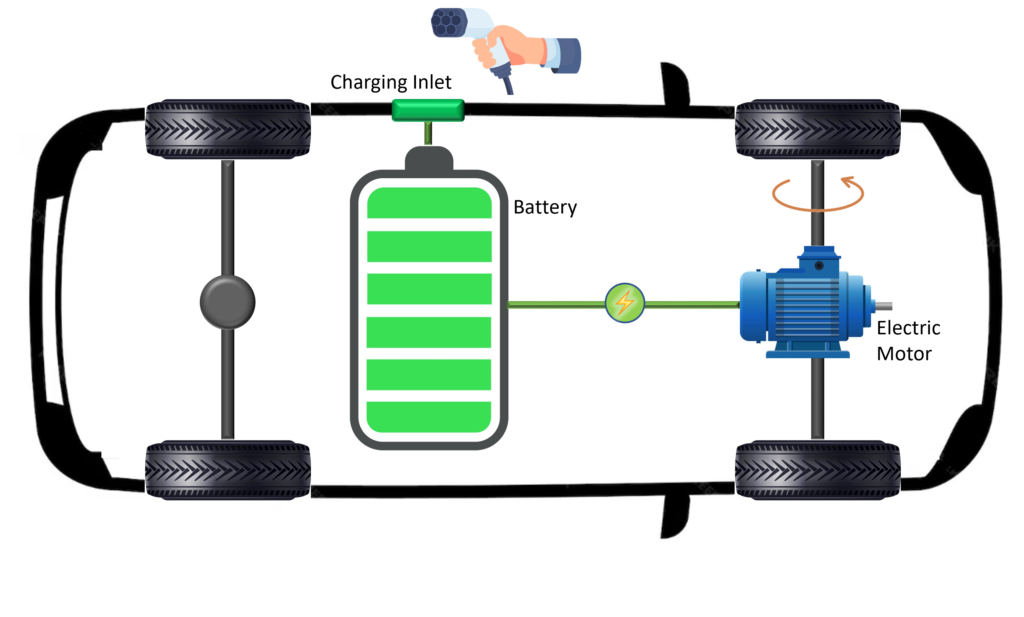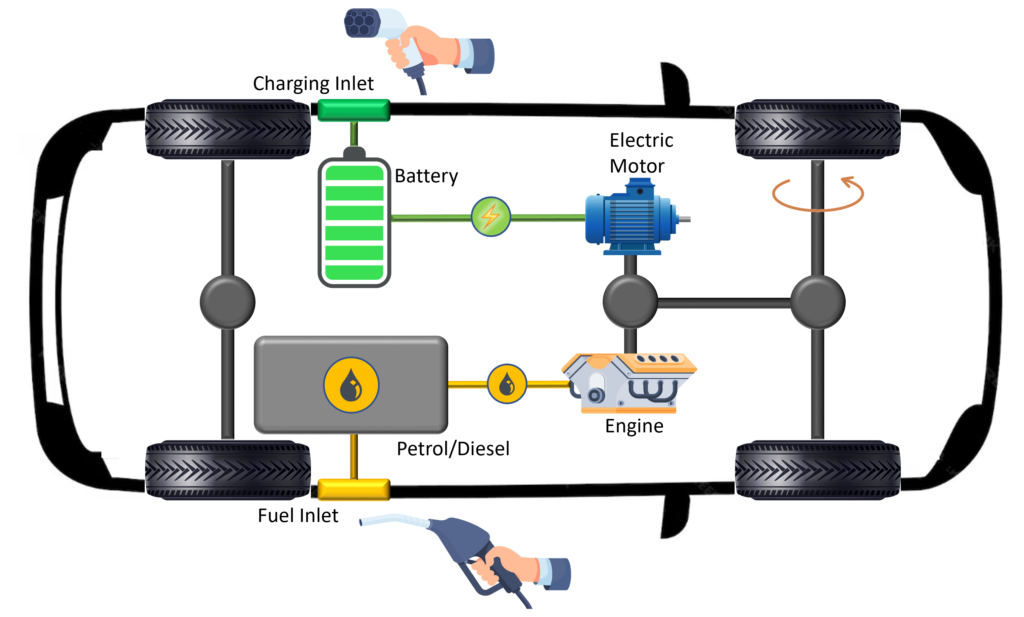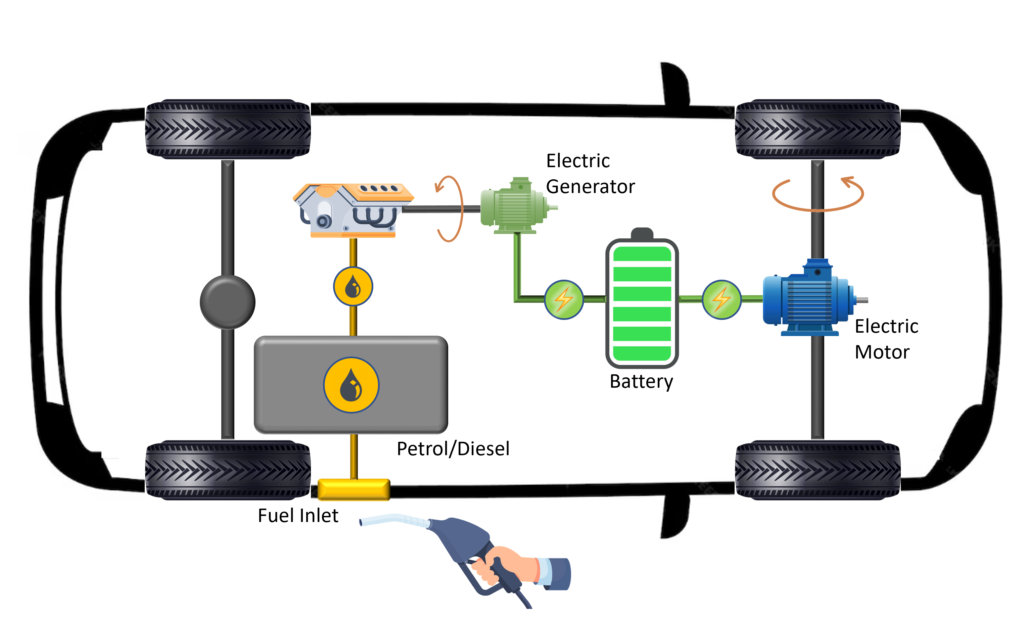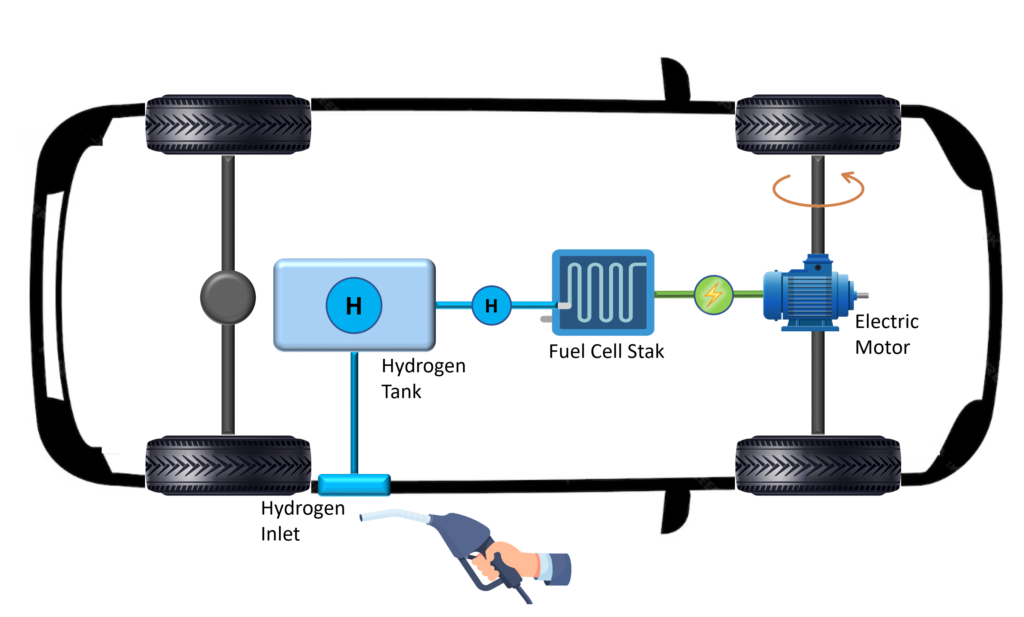What is an EV and what are the different types of EVs?
“EV” stands for “Electric Vehicle.” An electric vehicle is a type of vehicle that is powered by electricity, rather than traditional internal combustion engines (ICEs) fueled by gasoline/petrol or diesel. EVs use electric motors for propulsion and draw their energy from rechargeable battery packs or, in the case of hydrogen fuel cell vehicles, from electrochemical reactions.
EVs can be broadly classified according to their operational principles as follows:
- Battery Electric Vehicles (BEVs)
- Plug-in Hybrid Electric Vehicles (PHEVs)
- Hybrid Electric Vehicles (HEVs)
- Fuel Cell Electric Vehicles (FCEVs)
Lets discuss about each type of EV in brief, in the following sections.
1. Battery Electric Vehicles (BEVs):
What is a BEV?
BEVs utilize rechargeable battery packs as their energy source and employ electric motor(s) for vehicle propulsion. They do not have an internal combustion engine (ICE) and batteries need to be recharged with external energy source once depleted.
Other alternative names used for BEVs are Pure Electric Vehicles/Plug-In Electric Vehicles (PEVs), All-Electric Vehicles (AEVs), Full Electric Vehicles (FEVs) and Zero-Emission Vehicles (ZEVs). Also, EV is often used interchangeably with BEV.
What are the advantages?
- Zero emissions: BEVs produce no tailpipe emissions, making them an environmentally friendly option.
- Quiet operation: Electric motors are virtually silent, providing a quieter and more pleasant driving experience.
- Lower operating costs: BEVs have fewer moving parts, reducing maintenance costs, and electricity tends to be cheaper than gasoline.
- Energy efficiency: BEVs are highly efficient in converting electricity to propulsion, resulting in better energy utilization.
What are the limitations?
- Limited range: BEVs typically have a limited driving range compared to some other EV types and ICE vehicles.
- Charging infrastructure: The availability of charging stations can vary by region, affecting convenience.
- Charging time: Recharging the battery takes long time.
- More expensive: BEVs are more expensive than ICE vehicles because of the expensive battery packs in the vehicle.
What are the applications?
- Urban commuting: BEVs excel in urban environments with shorter commutes.
- Fleet vehicles: Many companies use BEVs for their fleets to reduce operating costs and emissions.
- Daily driving: BEVs are perfect for everyday use, such as running errands and commuting to work.
What are the example vehicles from the market?
Tesla Model S, Volvo EX 40 Recharge, Polestar 2, and Hyundai Ioniq 5 etc.

2. Plug-in Hybrid Electric Vehicles (PHEVs):
What is a PHEV?
PHEVs combines an ICE with an electric motor and a rechargeable battery pack. Both electric motor and ICE are mechanically connected to wheels and are utilized for propelling the vehicle. What sets PHEVs apart from traditional hybrid vehicles is their ability to be charged via an external power source, such as a wall outlet or a charging station.
PHEVs operate through a dynamic interplay between their ICE, electric motor, and rechargeable battery:
Electric Only Mode: When fully charged, PHEVs can run solely on electric power for a limited range, which varies among models. In this mode, the electric motor provides propulsion by consuming the power from battery, and no tailpipe emissions are produced.
Hybrid Mode: This mode combines the electric motor and ICE for efficient propulsion. The vehicle operates on electric power, internal combustion, or both, seamlessly switching to optimize fuel efficiency and reduce emissions based on driving conditions and battery charge.
Other alternative names used for PHEVs are Parallel Hybrid Vehicles and Range Extenders.
What are the advantages?
- Versatility: PHEVs can operate as electric vehicles for daily commutes and switch to hybrid mode for longer journeys, eliminating range anxiety.
- Reduced Emissions: PHEVs produce fewer overall emissions than traditional gasoline vehicles, because of the electric-only mode.
- Improved Fuel Efficiency: When operating in hybrid mode, PHEVs can achieve better fuel efficiency compared to conventional vehicles.
What are the limitations?
- Limited electric range: PHEVs have a very limited electric-only driving range, which may not be sufficient for some longer trips.
- Charging infrastructure: Access to charging infrastructure may vary, affecting the convenience of charging the battery.
- Higher initial cost: PHEVs are more expensive than traditional vehicles due to the additional components like the battery and electric motor.
- Complex design: PHEVs are difficult to design and develop because of the complex interactions between electric motor and ICE. This complex design may lead to more failures in the vehicle.
What are the applications?
- Urban and suburban commuting: PHEVs are ideal for urban and suburban commuting, allowing electric-only operation for local trips and hybrid mode for longer distances.
- Fleet vehicles: PHEVs are used in fleet applications, where their dual power sources offer a balance between efficiency and extended range for diverse driving needs.
What are the example vehicles from the market?
Toyota Prius Prime, Volvo XC60 T8 Recharge, Ford Escape, and Kia Niro etc.

3. Hybrid Electric Vehicles (HEVs):
What is a HEV?
HEVs have both an ICE and an electric motor with battery pack. But ICE is not mechanically connected to the wheels and it runs at its optimal efficiency to generate the electricity. This electricity is used to charge the battery pack, which then powers an electric motor that drives the vehicle. In contrast to PHEVs, battery pack cannot be recharged from external power source.
Other alternative name used for HEVs is Series Hybrid Vehicles.
What are the advantages?
- Smaller ICE: ICE can be smaller and optimized for efficiency since it doesn’t need to directly drive the wheels.
- Improved fuel efficiency: The ICE operates at its most efficient point, reducing fuel consumption and emissions.
- Quiet operation: The electric motor provides a quiet and smooth driving experience than conventional ICE vehicle.
What are the limitations?
- Less efficient for shorter commutes: They rely on the ICE to recharge the battery, making them less efficient if used primarily for short trips.
- Complex design: The dual powertrain configuration can increase vehicle complexity and maintenance costs.
- Higher initial cost: HEVs are more expensive than traditional vehicles due to the additional components like the battery and electric motor.
What are the applications?
- Fleet operations: Series HEVs can be cost-effective for commercial fleets with high daily mileage.
What are the example vehicles from the market?
Chevrolet Volt (First Generation), BMW i3 REx etc.

4. Fuel Cell Electric Vehicles (FCEVs or FCVs):
What is a FCEV?
FCEV uses a fuel cell stack to generate electricity on board and electrical motor is used to propel the vehicle. Unlike BEVs that store electricity in batteries, FCEVs utilize hydrogen gas as their primary fuel source. This hydrogen is chemically combined with oxygen from the air in a fuel cell to produce electricity, with the only byproduct being water vapor.
Other alternative names used for FCEVs are Hydrogen Fuel Cell Vehicles (HFCVs), Hydrogen-Powered Vehicles, H2 Vehicles and Hydrogen Cell Vehicles.
What are the advantages?
- Zero Emissions: FCEVs produce zero tailpipe emissions, contributing to cleaner air and reduced greenhouse gas emissions, as they only emit water vapor during operation.
- Quick Refueling: Hydrogen refueling can be as fast as refueling a gasoline vehicle, offering convenience like traditional ICE vehicles.
- Long Range: FCEVs often have longer driving ranges compared to many BEVs, making them suitable for long-distance travel.
What are the limitations?
- Limited Hydrogen infrastructure: Hydrogen refueling infrastructure is currently limited in many regions, restricting FCEV adoption.
- Hydrogen production: The production of hydrogen gas can involve energy-intensive processes, which may impact the overall environmental benefits.
- High manufacturing cost: FCEVs can be more expensive to manufacture compared to some other EV types.
- Durability and Cost of Fuel Cells: The durability and cost of fuel cells remain challenges, as they need to withstand the demands of automotive use while remaining cost-competitive with other propulsion technologies.
- Efficiency Concerns: The overall efficiency of the hydrogen production, distribution, and conversion process can be lower compared to the direct use of electricity in battery electric vehicles.
What are the applications?
- Fleet Vehicles: FCEVs can be beneficial for fleets that require consistent and efficient transportation for long distances.
What are the example vehicles from the market?
Availability of FCEVs is limited, several notable examples are Toyota Mirai, Hyundai Nexo, and Honda Clarity Fuel Cell etc.

EV Charging Explained – Everything you need to know about Electric Vehicle Charging